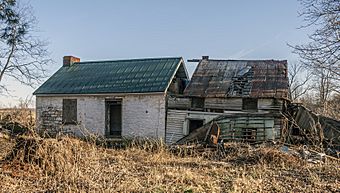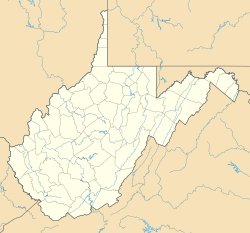Duffields station (Baltimore and Ohio Railroad) facts for kids
Quick facts for kids |
|
|
Duffields Depot
|
|

Duffields Depot, March 2012
|
|
| Nearest city | Shenandoah Junction, West Virginia |
|---|---|
| Area | 0.35 acres (0.14 ha) |
| Built | 1839 |
| NRHP reference No. | 07000780 |
| Added to NRHP | August 3, 2007 |
The Duffields station is a very old train station. It used to be part of the Baltimore and Ohio Railroad line. You can find it in a small village called Duffields, West Virginia. This historic building is close to Shenandoah Junction.
It was built way back in 1839. This makes it the second oldest train station still standing from the B&O Railroad. Only the Ellicott City Station in Ellicott City, Maryland is older. The station and its area were very important during the American Civil War. A famous event called the "Greenback Raid" happened here in 1864.
What it Looks Like
The Duffields station is located where Flowing Springs Road crosses the train tracks. It sits on Melvin Road, which runs next to the tracks. The building has two main parts. One part is made of stone and has a sloped roof. The other part is a wooden addition, also with a sloped roof.
The stone part is built into a hill. This is like a "bank barn" where one side is level with the road. The other side, facing the tracks, goes down the slope. The basement of the stone part has filled up with dirt over time. This stone section has two openings or "bays." Inside, there's a chimney that served two fireplaces. The walls are made of local limestone rocks.
The wooden part extends from the stone building. It also has two bays and continues the same roof style. This wooden section used to have a porch on its north side.
Inside the stone part, most of the original layout is still there. The first floor was likely split into two long, narrow rooms. There was also a finished attic space above. The room facing the tracks still has built-in cupboards and fancy wood trim. The wooden section has three rooms. Two rooms face the tracks, and one faces the road. These rooms have plaster walls and simple wood trim. The attic in the wooden section has two small rooms. Its roof is damaged, and the plaster inside is also broken.
Near the station, there's a shed and an outhouse. These were built in the 1930s. The outhouse was designed by the Works Progress Administration, a government program from that time.
History of the Station
Duffields station was a local stop for the B&O train line. It served people living in the countryside. Interestingly, the station was not built by the railroad company itself. A private person built it. The railroad had its own station across the tracks from 1883 to 1942.
Richard Duffield owned the land where the tracks were laid. The railroad paid him $2500 for the right to use his land. Mr. Duffield used this money to build the station. The railroad company was happy with this. They preferred to spend their money on building the train lines. They liked to use private stations whenever they could. The Duffields station was where the B&O station master lived and worked.
During the American Civil War, the station was a site of battles. Union soldiers guarded the station and its surroundings throughout the war. However, on June 29, 1864, a group called John S. Mosby's 43rd Battalion Virginia Cavalry briefly took control of the station.
Later, on October 14, 1864, Mosby's rangers caused trouble near Duffields. They cut the train tracks and made a train go off the rails. This event became known as the "Greenback Raid." Mosby's group took a large amount of money, over $150,000 in Federal cash, from the train.
Today, a group called Duffield Station, Inc. bought the property. They plan to fix it up and turn it into a museum. The Duffields Depot was officially added to the National Register of Historic Places on August 3, 2007. This means it is recognized as an important historic site.



